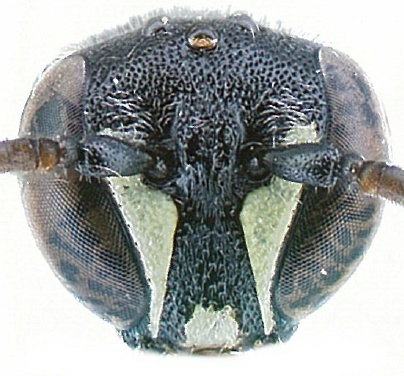Hylaeus in Hawaii

Hylaeus in Hawaii |

|
Hylaeus strenuusIslands: OahuLocations: None Habitats: Coast, lowlands, montane Plants: Erythrina, Metrosideros, Scaevola Xerces: No info. Insects of Hawaii: Insects of Hawaii Volume 17 
UH/DOD: In 2007, a new immigrant Hylaeus was reported from Oahu, and later identified as Hylaeus (Indialaeus) strenuus (Dathe 2011, Magnacca et al. 2011). The initial collections were strictly from coastal sites in the east Honolulu area, primarily on Scaevola taccada, and it was expected to be a potential serious competitor to the native coastal Hylaeus. Since then, it has spread throughout the island. At present, its habitat preferences are difficult to discern (all Indialaeus species are virtually unknown in their native range). In this survey, it was found at the coast broadly along Mokuleia beach, east of Kaena, and at Sandy Beach and Kaloko, near the H. anthracinus populations. Two collections were made on Metrosideros polymorpha flowers on adjacent ridges in the central Koolau range, indicating the potential to invade montane habitats. However, it was not recovered from some of the earlier sites where it was found, including Ala Moana Beach Park, suggesting it may not be competitive in these habitats. At the same time, it was consistently found at Erythrina flowers, both the native E. sandwicensis (wiliwili) and various introduced ornamental or cultivated species. These flowers are clearly evolved to be bird-pollinated – they are large, predominantly red to orange, with a large quantity of relatively dilute nectar concealed beneath overlapping petals – and no bees or other insects were seen visiting them, though honeybees are known to do so occasionally. Individuals of H. strenuus were repeatedly observed both climbing the long stamens to collect pollen, and extruding a droplet of nectar while resting on a branch in order to concentrate it (Figure 11). Members of the subgenus Indialaeus are distinctive for their broad, flat mandibles, which may be adapted for the purpose of holding these droplets. The ability of these bees to find remote Erythrina populations, the behavioral and morphological characters they exhibit, and their relatively limited distribution in native Hylaeus habitat after at least five years suggests that H. strenuus may not be a serious competitor to the native species, but it should be monitored. Hylaeus near military lands 
Other: |

|